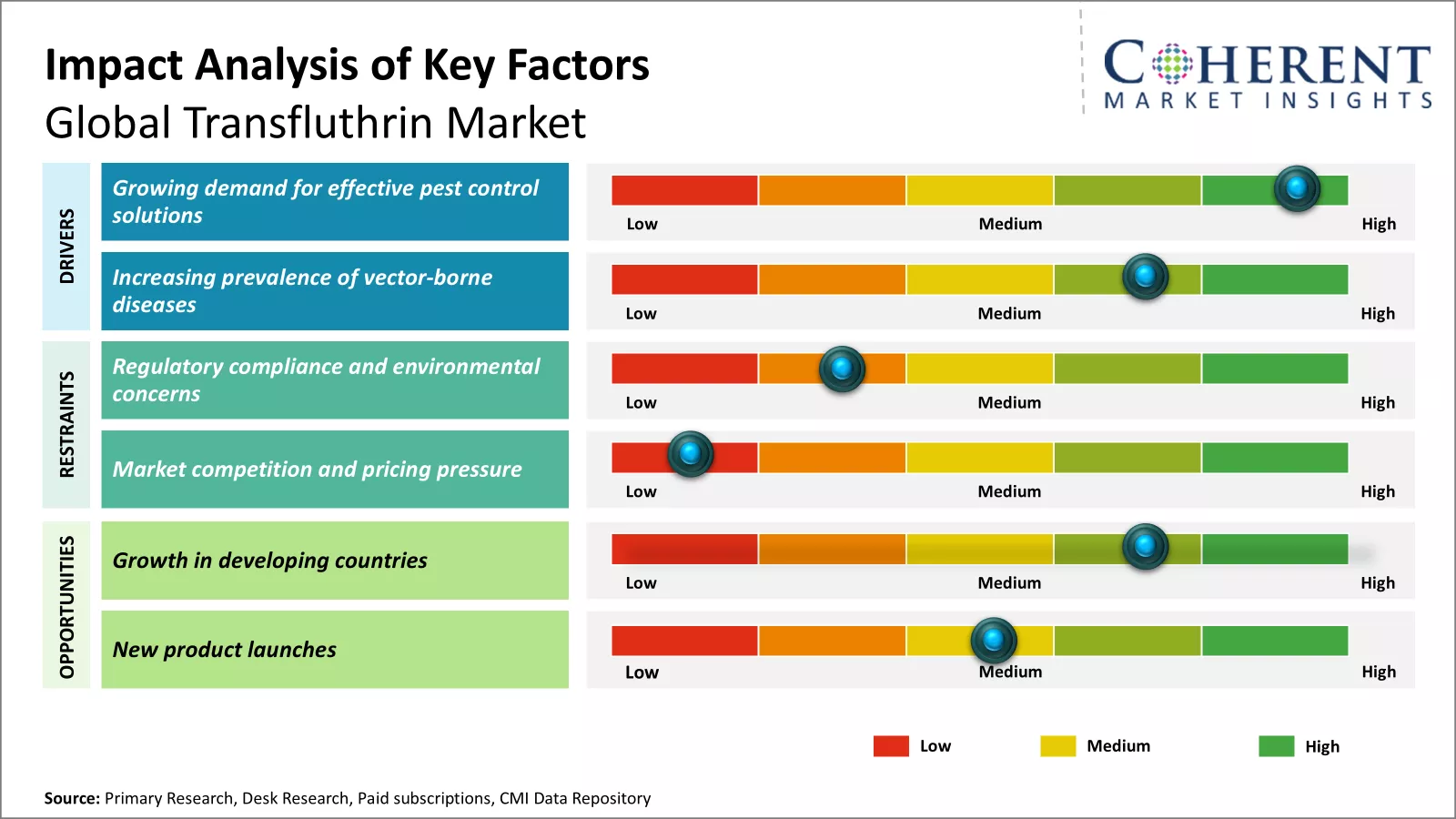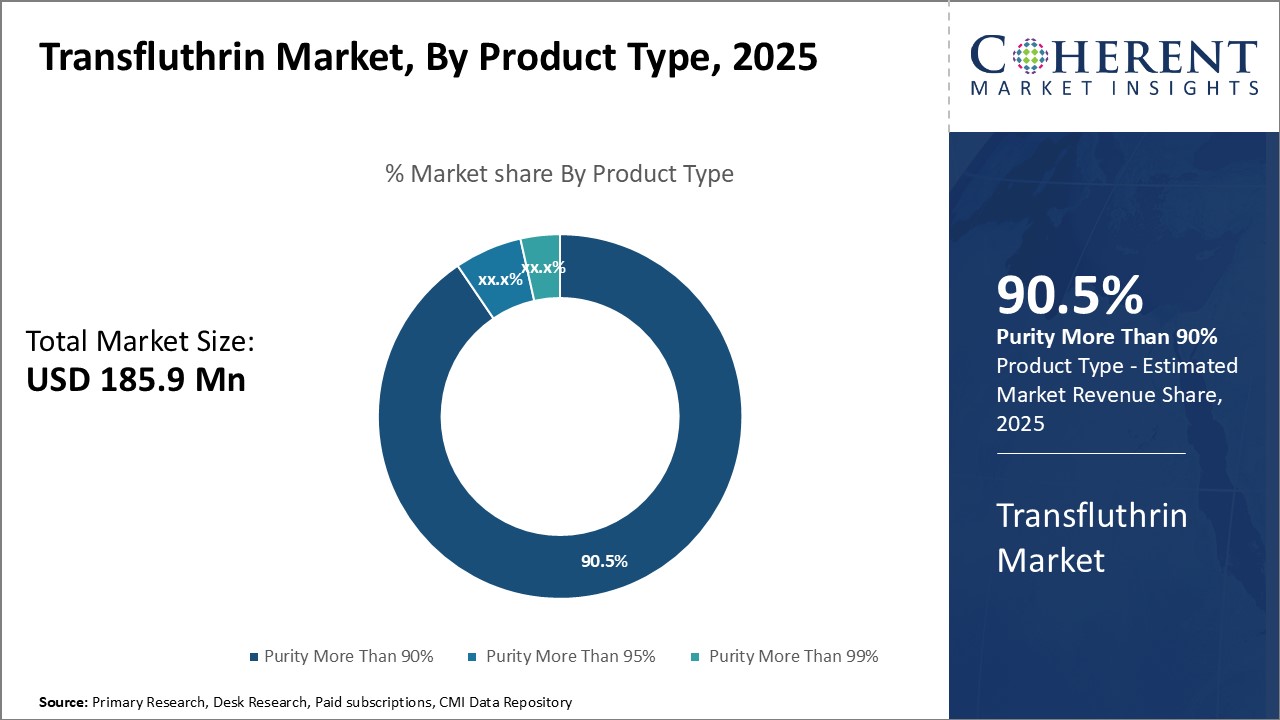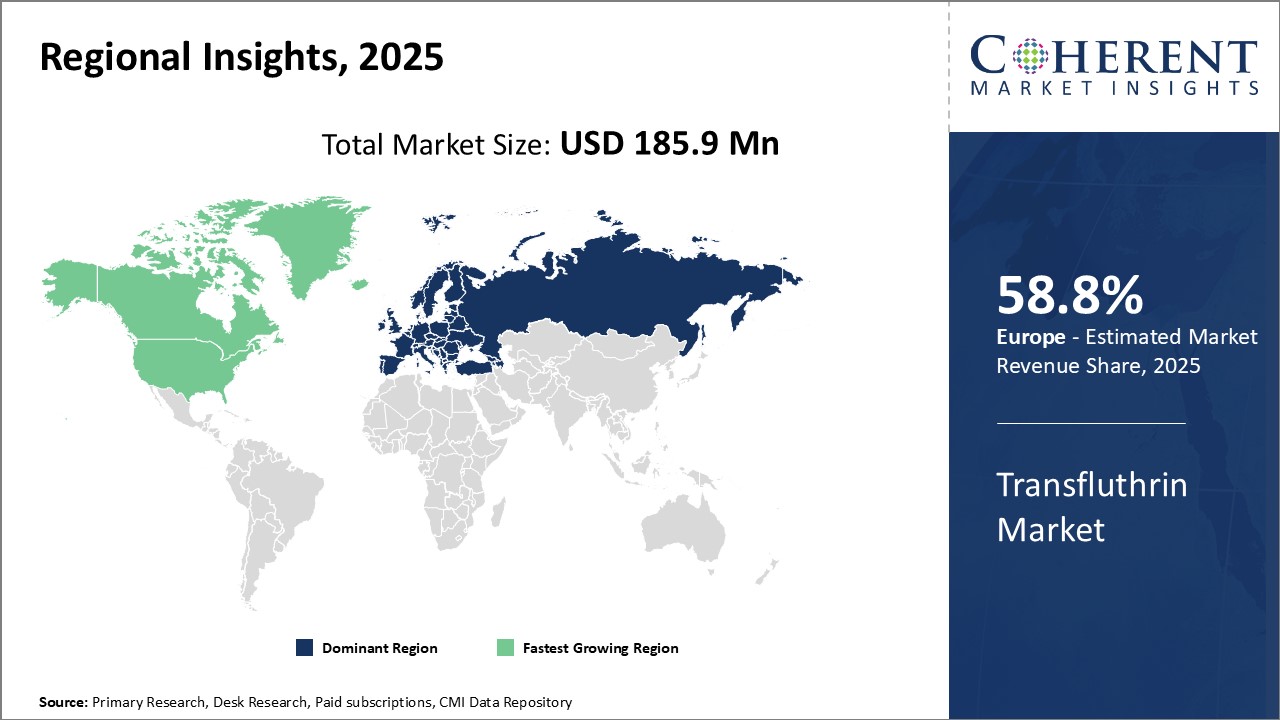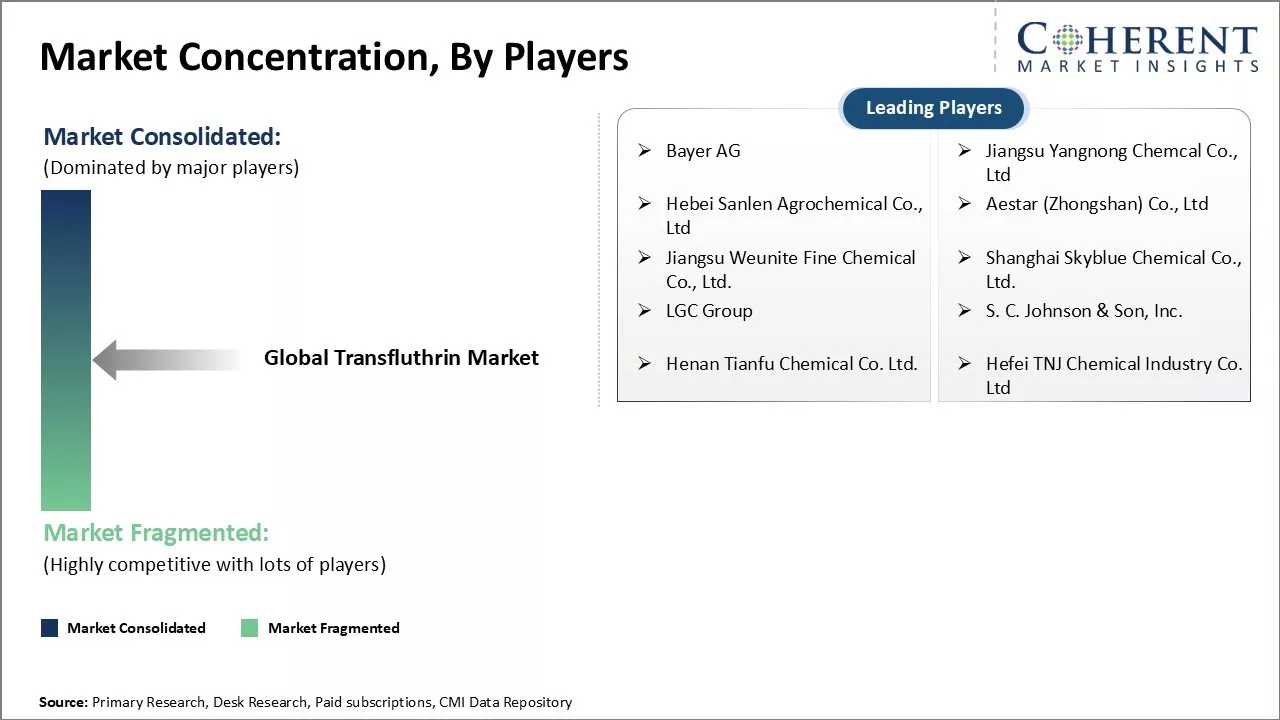Global transfluthrin market is estimated to be valued at USD 185.9 Mn in 2025 and is expected to reach USD 254.8 Mn by 2032, exhibiting a compound annual growth rate (CAGR) of 4.6% from 2025 to 2032. Increasing demand for transfluthrin from mosquito repellents and other applications has been the key factor driving the market growth.

Discover market dynamics shaping the industry: Download Free Sample
Transfluthrin acts as an effective repellent and has been extensively used for developing various mosquito repellents. Growing awareness regarding vector borne diseases and need for effective repellents have further augmented the demand for transfluthrin in both developing and developed countries. Increasing spending on personal care and effective mosquito control products is also contributing to the market growth.

Discover high revenue pocket segments and roadmap to it: Download Free Sample
Insights By Product Type: Purity more than 90% segment dominates as it is cost-effective
In terms of product type, purity more than 90 % segment is expected to contribute 90.5% share of the market in 2025, owing to its excellent balance of effectiveness and cost. This purity level contains just enough active ingredient to effectively combat common pests while maintaining an affordable price point.
Insights By Application: Mosquito Repellents maintain leadership as demand from tropical regions rises
In terms of application, mosquito repellents segment is expected to contribute 34.8% share of the market in 2025. Increased use of insect repellents eventually contributes to the expansion of the market. Mosquitoes transmit dangerous diseases and their bites cause irritation, making effective repellents a high priority purchase. Regions with tropical climates and marshy environments experience more intense activities of mosquitoes, driving especially strong sales of repellents.

Need a Different Region or Segment? Download Free Sample
Regional Analysis: Global Transfluthrin Market
Dominating Region: Europe
Europe is expected to account for the greatest revenue share of 58.8% in 2025. Increased awareness about health and hygiene has led to the higher consumption of insect repellents. Major companies operating in Europe are investing in research and development to enhance product formulations.
Fastest-Growing Region: North America
North America is experiencing rapid growth in this market, driven by rising concerns about vector-borne diseases and pest infestations. The increase in diseases transmitted by insects has led to higher demand for effective repellents. The rise of e-commerce platforms has made it easier for consumers to access a variety of transfluthrin products.
Transfluthrin Market Outlook for Key Countries
Benefits of Transfluthrin in crop protection in the U.S.
The U.S. market for transfluthrin benefits from high demands for crop protection and early adoption of innovative solutions. Major players like Bayer continue to invest in research and development of advanced formulations. There is a rising trend towards using chemical repellents due to their effectiveness and ease of use, which is further driving the market growth in the country.
Growing agriculture economy in Germany
Germany’s market for transfluthrin is supported by burgeoning requirements of the agriculture-driven economy and increasing exports of farm produce. Companies such as Syngenta have established R&D centers to cater to the country’s evolving landscape. The market is expected to grow steadily due to increasing awareness about health risks associated with insect bites.
Presence of major agrochemical companies in France
France continues to lead as one of the top consumers of agrochemicals owing to its large and diverse farming sector. Local manufacturers have strengthened their presence through collaborative initiatives as well as independent product launches. Factors such as rising temperatures and changing climate patterns are likely to increase pest populations, boosting the market growth.
Canada’s dominant position in exporting commodities
Canada’s market expansion coincides with the country's position as a dominant global exporter of commodities. Focus on quality and sustainability has drawn attention towards reliable brands and newer technologies. Growing awareness about the health risks associated with insect bites is driving demand for effective repellents.

Get actionable strategies to beat competition: Download Free Sample
Top Strategies Followed by Global Transfluthrin Market Players
Emerging Startups in the Global Transfluthrin Market
Innovative Technologies: GreenPly Labs is developing biodegradable and zero-waste transfluthrin packaging using materials like banana fibers and cassava starch. Its plant-based alternatives can significantly reduce plastic waste. DeepWatch uses AI to analyze transfluthrin product sales data and predict emerging industry trends to help firms adapt strategies accordingly. Developing eco-friendly formulations that minimize environmental impact. Implementing advanced technologies for better efficacy and safety in pest control.
Sustainable Solutions: BetterEarth Organics produces transfluthrin-coated jute bags that control pests in stored grains without harming people or the environment. Its bags can be reused or incorporated into compost after use. Biobase focuses on formulating eco-friendly and non-toxic transfluthrin solutions made from plant extracts helping reduce chemical residue issues. Market Contribution: Small startups like Greenvention address unique localized pest challenges through specialized transfluthrin mixtures.
Key Takeaways from Analyst
Transfluthrin Market Report Coverage
| Report Coverage | Details | ||
|---|---|---|---|
| Base Year: | 2024 | Market Size in 2025: | USD 185.9 Mn |
| Historical Data for: | 2020 To 2024 | Forecast Period: | 2025 To 2032 |
| Forecast Period 2025 to 2032 CAGR: | 4.6% | 2032 Value Projection: | USD 254.8 Mn |
| Geographies covered: |
|
||
| Segments covered: |
|
||
| Companies covered: |
Bayer AG, Jiangsu Yangnong Chemcal Co., Ltd, Hebei Sanlen Agrochemical Co., Ltd, Aestar (Zhongshan) Co., Ltd, Jiangsu Weunite Fine Chemical Co., Ltd., Shanghai Skyblue Chemical Co., Ltd., LGC Group, S. C. Johnson & Son, Inc., Henan Tianfu Chemical Co. Ltd., and Hefei TNJ Chemical Industry Co. Ltd |
||
| Growth Drivers: |
|
||
| Restraints & Challenges: |
|
||
Uncover macros and micros vetted on 75+ parameters: Get instant access to report
Market Driver - Growing demand for effective pest control solutions
Urbanization is rapidly increasing, leading to higher risks of pest infestations and disease transmission. Transfluthrin, known for its low mammalian toxicity and residue-free use, has gained popularity in homes and commercial spaces. Between 2020 and 2022, sales of transfluthrin products surged in North America, Europe, and parts of Asia Pacific, driven by heightened public concerns over insect infestations during the global pandemic, according to the UN Food and Agriculture Organization.
Market Challenge - Regulatory compliance and environmental concerns
One of the key challenges impacting on this market is strict regulatory compliance and growing environmental concerns surrounding the use of synthetic pesticides. Transfluthrin is a synthetic pyrethroid pesticide that is used extensively in agricultural as well as commercial and residential settings for insect control. Studies by the UN Environment Programme have found that pyrethroids can have negative effects on aquatic ecosystems if they enter water bodies through agricultural or urban run-off.
Market Opportunity - Growth in Developing Countries
One of the major opportunities for this market lies in the growing demand from developing and under-developed countries. For example, average income levels in India have grown over 30% from 2015-2020 according to the World Bank data reported in 2021. This is enabling more people to spend adequately on healthcare and preventive products. Furthermore, many developing nations are also improving public health infrastructure through various initiatives of WHO, World Bank, and other global partners.
Share
Share
About Author
Yash Doshi is a Senior Management Consultant. He has 12+ years of experience in conducting research and handling consulting projects across verticals in APAC, EMEA, and the Americas.
He brings strong acumen in helping chemical companies navigate complex challenges and identify growth opportunities. He has deep expertise across the chemicals value chain, including commodity, specialty and fine chemicals, plastics and polymers, and petrochemicals. Yash is a sought-after speaker at industry conferences and contributes to various publications on topics related commodity, specialty and fine chemicals, plastics and polymers, and petrochemicals.
Missing comfort of reading report in your local language? Find your preferred language :
Transform your Strategy with Exclusive Trending Reports :
Frequently Asked Questions
Joining thousands of companies around the world committed to making the Excellent Business Solutions.
View All Our Clients